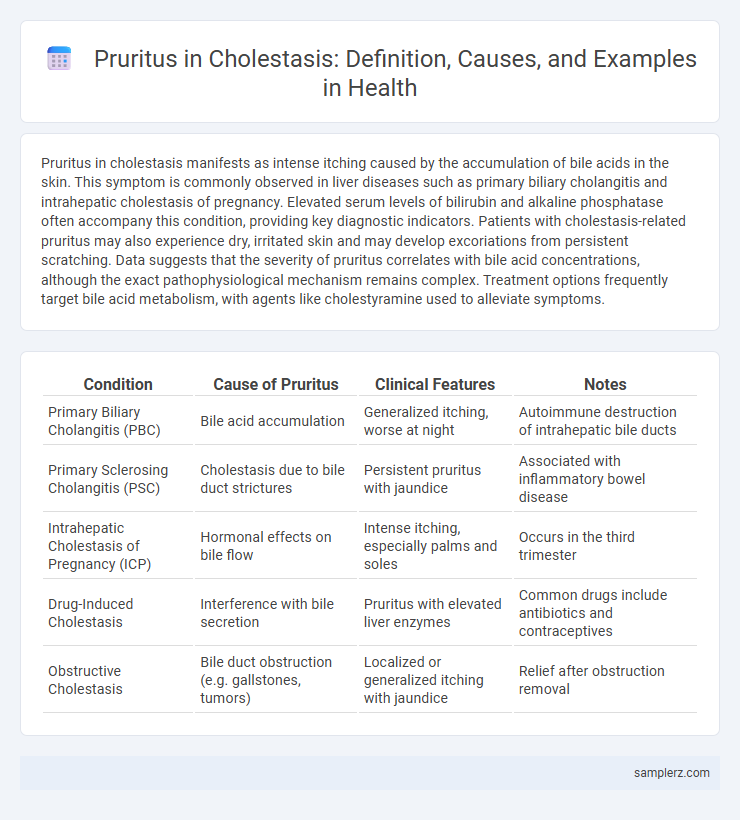Pruritus in cholestasis manifests as intense itching caused by the accumulation of bile acids in the skin. This symptom is commonly observed in liver diseases such as primary biliary cholangitis and intrahepatic cholestasis of pregnancy. Elevated serum levels of bilirubin and alkaline phosphatase often accompany this condition, providing key diagnostic indicators. Patients with cholestasis-related pruritus may also experience dry, irritated skin and may develop excoriations from persistent scratching. Data suggests that the severity of pruritus correlates with bile acid concentrations, although the exact pathophysiological mechanism remains complex. Treatment options frequently target bile acid metabolism, with agents like cholestyramine used to alleviate symptoms.
Table of Comparison
| Condition | Cause of Pruritus | Clinical Features | Notes |
|---|---|---|---|
| Primary Biliary Cholangitis (PBC) | Bile acid accumulation | Generalized itching, worse at night | Autoimmune destruction of intrahepatic bile ducts |
| Primary Sclerosing Cholangitis (PSC) | Cholestasis due to bile duct strictures | Persistent pruritus with jaundice | Associated with inflammatory bowel disease |
| Intrahepatic Cholestasis of Pregnancy (ICP) | Hormonal effects on bile flow | Intense itching, especially palms and soles | Occurs in the third trimester |
| Drug-Induced Cholestasis | Interference with bile secretion | Pruritus with elevated liver enzymes | Common drugs include antibiotics and contraceptives |
| Obstructive Cholestasis | Bile duct obstruction (e.g. gallstones, tumors) | Localized or generalized itching with jaundice | Relief after obstruction removal |
Understanding Pruritus in Cholestasis
Pruritus in cholestasis commonly presents as intense itching due to the accumulation of bile acids in the bloodstream, which irritate nerve endings in the skin. This symptom is frequently observed in liver diseases such as primary biliary cholangitis and intrahepatic cholestasis of pregnancy. Effective management involves targeting bile acid retention through medications like ursodeoxycholic acid and bile acid sequestrants to reduce itching severity.
Common Symptoms of Cholestatic Pruritus
Cholestatic pruritus commonly presents with intense itching often worsening at night and affecting the palms and soles. Patients may experience dry, scaly skin and excoriations due to persistent scratching. Elevated serum bile acids and bilirubin levels correlate strongly with the severity of pruritus in cholestasis.
Mechanisms Behind Pruritus in Cholestasis
Pruritus in cholestasis primarily results from the accumulation of bile acids in the skin, which activate itch-specific receptors and sensory neurons. Elevated levels of endogenous opioids and lysophosphatidic acid (LPA) also contribute to the neuropathic itch by sensitizing pruriceptive pathways. These biochemical changes disrupt normal skin homeostasis, intensifying the chronic itch experienced by cholestatic patients.
Case Study: Pruritus in Primary Biliary Cholangitis
Pruritus in Primary Biliary Cholangitis (PBC) presents as persistent, severe itching due to impaired bile acid excretion and elevated serum bile salt levels. A case study highlights a 52-year-old female patient with PBC experiencing debilitating pruritus unresponsive to antihistamines but showing improvement with bile acid sequestrants and rifampicin. Management of cholestatic pruritus in PBC requires targeted therapies addressing bile acid metabolism to reduce symptom severity and enhance quality of life.
Pruritus in Intrahepatic Cholestasis of Pregnancy
Pruritus in intrahepatic cholestasis of pregnancy (ICP) predominantly affects the palms and soles, intensifying in the evening and significantly impairing quality of life. Elevated serum bile acids serve as a key biomarker correlating with the severity of itching in ICP. Effective management includes ursodeoxycholic acid therapy, which reduces bile acid levels and alleviates pruritus symptoms.
Pruritus Manifestations in Primary Sclerosing Cholangitis
Pruritus in primary sclerosing cholangitis (PSC) typically presents as intense, generalized itching that worsens at night and often affects the palms and soles. This symptom results from the accumulation of bile acids and other pruritogens in the bloodstream due to impaired bile flow and cholestasis. Effective management includes bile acid sequestrants and emerging therapies targeting the underlying dysregulation of bile acid metabolism.
Pediatric Cases of Pruritus Due to Cholestasis
Pediatric cases of pruritus due to cholestasis often present with intense itching caused by the accumulation of bile acids in the skin. Conditions such as biliary atresia and progressive familial intrahepatic cholestasis are common cholestatic disorders in children that lead to severe pruritus. Effective management typically involves bile acid sequestrants and antipruritic medications to alleviate symptoms and improve quality of life.
Differentiating Pruritus in Acute vs. Chronic Cholestasis
Pruritus in acute cholestasis often presents suddenly with intense itching, accompanied by rapid onset of jaundice and elevated serum bilirubin levels. In chronic cholestasis, itching tends to be persistent and progressive, correlating with prolonged bile acid accumulation and visible skin excoriations. Differentiating these conditions requires evaluating biochemical markers such as alkaline phosphatase, gamma-glutamyl transferase, and bile acid concentrations, alongside clinical history and liver imaging.
Diagnostic Criteria for Cholestatic Pruritus
Pruritus in cholestasis is characterized by intense, often generalized itching without primary skin lesions, frequently worsening at night. Diagnostic criteria for cholestatic pruritus include elevated serum bile acid levels, alkaline phosphatase, and gamma-glutamyl transferase, alongside clinical signs of cholestasis such as jaundice and hepatomegaly. Liver function tests combined with patient history and exclusion of other pruritic conditions are essential for accurate diagnosis.
Impact of Cholestatic Pruritus on Quality of Life
Cholestatic pruritus, a persistent and severe itching associated with liver diseases such as primary biliary cholangitis and primary sclerosing cholangitis, significantly impairs patients' quality of life. This condition disrupts sleep patterns, increases psychological distress including anxiety and depression, and limits daily activities due to constant discomfort. Effective management of pruritus is critical to improving overall wellbeing and reducing the burden of cholestatic liver diseases.

example of pruritus in cholestasis Infographic
 samplerz.com
samplerz.com